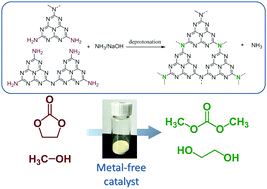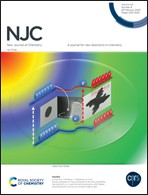Metal-free synthesis of dimethyl carbonate via transesterification of ethylene carbonate catalyzed by graphitic carbon nitride materials†
Abstract
Catalytic transesterification reaction between a cyclic carbonate and a low alcohol is the most important and practical strategy for the manufacture of dimethyl carbonate and other alkyl carbonates. However, most developed heterogeneous catalysts have potential metal and halide contamination. Herein, a graphitic carbon nitride (g-C3N4) material has been synthesized, thermally exfoliated, and treated with an alkaline solution. The physicochemical properties of eg-C3N4 materials have been analyzed by XRD, TG, N2 adsorption–desorption, FT-IR, UV-vis, and XPS spectroscopy. The characterization results reveal that the exfoliation has effectively enhanced the surface area of g-C3N4, and alkaline treatment could lead to the deprotonation of eg-C3N4, depending on the treatment temperature and alkaline solution. In the transesterification reaction between ethylene carbonate and CH3OH, the eg-C3N4-NH3 catalyst demonstrates superior catalytic activity to the pure g-C3N4, eg-C3N4 and eg-C3N4-HCl, affording a maximum DMC yield of 60% at 393 K. Furthermore, the eg-C3N4-NH3 shows good catalytic reproducibility and versatility for other substrates.



 Please wait while we load your content...
Please wait while we load your content...